The influence of foliar applied silicic acid on N, P, K, Ca and Mg concentrations in field peas<sup>*</sup>
Keywords:
Calcium, magnesium, nitrogen, pea, Pisum sativum, phosphorus, potassium, silicic acidAbstract
Silicon (Si) is the second most abundant element after oxygen in soil. However, many field studies have shown that supplying crops with extra Si in form of finely dispersed SiO2 · n H2O (= silicic acid “dissolved” in water) suppresses plant disease, reduces insect attack, improves environmental stress tolerance, and increases crop productivity.
The purpose of this investigation was to look at the influence of foliar applied silicic acid on the chemical content of field peas of variety Mehis. Silicic acid was applied as an aqueous spray applied in different concentrations from the 2–3 true leaf stage at two-week intervals from 21 May to 2 July 2014, in total 108 g ha–1 Si. Silicic acid partially improved the quality of field peas of variety Mehis by increasing phosphorus and potassium concentrations in the peas. It is suggested that foliar applied silicic acid may improve root growth through an improved phosphorus supply and also the water status of the plants through an improved potassium supply.
DOI: 10.5073/JfK.2016.01.02, https://doi.org/10.5073/JfK.2016.01.02
Published
Issue
Section
License
The content of the journal is licensed under the Creative Commons Attribution 4.0 License. Any user is free to share and adapt (remix, transform, build upon) the content as long as the original publication is attributed (authors, title, year, journal, issue, pages).
The copyright of the published work remains with the authors. The authors grant the Journal of Cultivated Plants, the Julius Kühn-Institut and the OpenAgrar repository the non-exclusive right to distribute and exploit the work.







